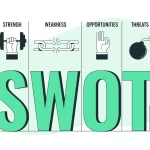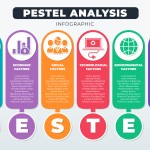Introduction
In the complex world of business, understanding and optimizing operations is key to achieving strategic goals and sustaining competitive advantage. Business analysis techniques are indispensable tools that equip organizations with the insights needed to make informed decisions, enhance operational efficiency, and navigate market dynamics effectively. From SWOT and PESTLE analysis that shed light on strategic positioning and external factors to business process modeling and data flow diagramming that streamline operations and system design, these techniques offer a multifaceted approach to dissecting business challenges. This article delves into the best tools and methods in business analysis, illustrating how they can transform organizational processes and decision-making frameworks to foster growth and adaptability in a rapidly evolving business landscape.
What Is Business Analysis?
Business analysis is a research discipline that involves identifying business needs and determining solutions to business problems. Solutions frequently encompass a component of systems development, but they can also involve enhancements in processes, organizational transformation, or the formulation of strategic plans and policy. The individual responsible for executing these tasks is known as a business analyst or BA. Business analysis aims to facilitate change within an organization by defining needs and recommending solutions that deliver value to stakeholders. This involves understanding how organizations function to accomplish their purposes, defining the capabilities an organization requires to provide products and services to external stakeholders, and the identification and documentation of internal and external business requirements. Additionally, business analysis includes the creation of viable and sustainable solutions to meet those requirements, usually in the context of organizational change.
Why Is Business Analysis Critical for Organizations?
Business analysis is critical for organizations for several reasons:
- Aligns Business Processes with Strategic Goals:It ensures that the operational processes of an organization are in alignment with its strategic objectives, thereby facilitating effective achievement of goals.
- Identifies Improvement Opportunities:Through thorough examination of business processes, business analysis identifies areas of inefficiency, bottlenecks, and processes that can be optimized for better performance.
- Facilitates Change Management: It plays a crucial role in managing change within an organization by identifying the requirements for change, and the potential impacts, thereby ensuring smooth transition processes.
- Enhances Decision-Making:By providing detailed insights into business operations, customer needs, and market trends, business analysis supports informed decision-making at all levels of the organization.
- Improves Customer Satisfaction:By understanding and documenting customer needs and aligning business processes to meet these needs, business analysis helps in improving the quality of products/services and thus customer satisfaction.
- Risk Management:It helps in identifying potential risks in business processes and proposing mitigation strategies, thus minimizing the likelihood of their occurrence.
- Cost Reduction:By identifying unnecessary processes and suggesting improvements, business analysis can significantly reduce costs and increase the efficiency of operations.
- Promotes Innovation:By constantly evaluating market trends and customer needs, business analysis fosters an environment of innovation within the organization, encouraging the development of new products/services or the improvement of existing ones.
Table1 : The Crucial Role of Business Analysis in Organizations
Aspect | Description |
Aligns Business Processes with Strategic Goals | Ensures organizational operations align with strategic objectives to achieve goals effectively. |
Identifies Improvement Opportunities | Finds inefficiencies and bottlenecks in business processes for optimization and better performance. |
Facilitates Change Management | Manages organizational change by assessing change requirements and impacts for a smooth transition. |
Enhances Decision-Making | Supports informed decisions through insights into business operations, customer needs, and market trends. |
Improves Customer Satisfaction | Aligns business processes to meet customer needs, enhancing product/service quality and satisfaction. |
Risk Management | Identifies potential business risks and proposes mitigation strategies to minimize occurrences. |
Cost Reduction | Suggests process improvements to eliminate unnecessary operations, reducing costs and increasing efficiency. |
Promotes Innovation | Encourages innovation by evaluating market trends and customer needs for new or improved products/services. |
In summary, business analysis is essential for organizations as it facilitates better management of processes, projects, and change, leading to improved efficiency, reduced costs, and enhanced competitiveness in the market.
How Can SWOT Analysis Drive Strategic Decision-Making?
SWOT Analysis, a strategic planning tool that identifies Strengths, Weaknesses, Opportunities, and Threats related to business competition or project planning, is instrumental in driving strategic decision-making in several ways:
- Clarifies Internal Capabilities and Challenges:By identifying an organization's internal strengths and weaknesses, SWOT Analysis helps leaders understand what they are doing well and where they can improve. This clarity supports informed decision-making in resource allocation, process improvements, and strategic planning.
- Identifies External Opportunities and Risks:The analysis of opportunities and threats allows organizations to identify external factors that could impact their success. Recognizing these allows for proactive strategy development to capitalize on opportunities and mitigate potential risks.
- Facilitates Goal Setting: Understanding the internal and external environments through SWOT Analysis aids in setting realistic and achievable strategic goals that are aligned with both the organization's capabilities and market realities.
- Supports Strategic Alignment:By using SWOT to analyze various aspects of the organization and its environment, leaders can ensure that their strategies are coherent and aligned with overall objectives, enhancing the effectiveness of strategic initiatives.
- Encourages Cross-functional Collaboration: The process of conducting a SWOT Analysis often involves input from various departments, fostering cross-functional collaboration and a shared understanding of strategic priorities across the organization.
- Improves Competitiveness: By continuously evaluating strengths, weaknesses, opportunities, and threats, organizations can adapt more quickly to market changes and competitors’ strategies, maintaining or improving their competitive position.
- Aids in Risk Management:The identification of threats and weaknesses serves as a foundation for developing robust risk management strategies, reducing the likelihood and impact of potential negative events.
- Promotes Strategic Innovation:The insights gained from a SWOT Analysis can inspire innovative strategies that leverage strengths and opportunities while addressing weaknesses and threats, driving growth and differentiation in the market.
In essence, SWOT Analysis is a powerful tool for strategic decision-making, offering comprehensive insights that help organizations navigate complex environments, make informed choices, and strategically position themselves for success.
What Role Does PESTLE Analysis Play in Understanding Market Dynamics?
PESTLE Analysis significantly aids organizations in comprehending the broader market dynamics by examining six key external factors that could impact their operations. Here is how it plays a vital role:
- Political Factors:By evaluating the political environment, including government policies, trade restrictions, and political stability, PESTLE Analysis helps organizations assess how political decisions and changes might affect their market position and operational strategies.
- Economic Factors:This aspect of the analysis provides insights into economic trends such as inflation rates, interest rates, economic growth patterns, and exchange rates. Understanding these factors enables businesses to anticipate market shifts and adjust their strategies for economic downturns or growth periods.
- Social Factors: PESTLE Analysis examines societal trends, demographic changes, lifestyle shifts, and consumer behaviors. This helps organizations tailor their products, marketing strategies, and operations to meet the evolving needs and preferences of their target audience.
- Technological Factors: By analyzing emerging technologies, innovation rates, and technology adoption, businesses can identify opportunities for competitive advantage. It also helps them stay ahead of technological disruptions that could impact their market or operations.
- Legal Factors: This involves understanding the legal landscape, including employment laws, health and safety regulations, and consumer protection laws. Legal analysis ensures that organizations remain compliant and mitigate the risks of legal challenges.
- Environmental Factors: Environmental concerns, including climate change, sustainability practices, and environmental regulations, are increasingly influencing business operations and consumer preferences. Analyzing these factors enables organizations to adopt sustainable practices and address environmental concerns in their business strategies.
By providing a comprehensive overview of the external environment, PESTLE Analysis helps organizations understand the complex interplay of factors that shape market dynamics. This understanding enables them to make informed strategic decisions, capitalize on opportunities, and mitigate risks, ensuring long-term sustainability and success in a changing market landscape.
How Can Business Process Modeling Enhance Operational Efficiency?
Business Process Modeling (BPM) significantly enhances operational efficiency by providing a structured, visual representation of an organization's activities and workflows. Here’s how BPM can improve efficiency:
- Streamlining Processes: BPM identifies redundancies and bottlenecks within processes, offering insights into areas that can be simplified or automated. Streamlining these processes reduces unnecessary steps, saving time and resources.
- Standardizing Operations: By mapping out business processes, BPM ensures consistency across the organization. Standardized procedures reduce variability, improve quality, and ensure that best practices are followed, enhancing overall operational efficiency.
- Facilitating Continuous Improvement:BPM provides a baseline for current processes, which can be analyzed and improved over time. This iterative approach to process improvement ensures that operations remain efficient and effective in the face of changing business needs.
- Improving Communication and Collaboration: Visual models created through BPM facilitate better understanding among stakeholders. Clear process documentation enhances communication between departments, leading to more coordinated and efficient operations.
- Supporting Strategic Decision-Making: BPM helps align business processes with organizational goals and strategies. By understanding how different processes contribute to broader business objectives, decision-makers can prioritize improvements that offer the most significant impact on efficiency and performance.
- Enabling Automation:BPM identifies processes or tasks that are candidates for automation. Automating repetitive, time-consuming tasks not only speeds up operations but also reduces the likelihood of errors, contributing to more efficient workflow management.
- Enhancing Compliance and Risk Management:By clearly documenting processes, BPM ensures that operations comply with relevant regulations and standards. This helps in identifying and mitigating risks associated with non-compliance, avoiding potential fines and reputational damage.
- Increasing Agility:BPM allows organizations to quickly adapt their processes in response to market changes or internal challenges. This agility ensures that operations remain efficient even as the business evolves.
By improving clarity, reducing waste, and enhancing coordination, Business Process Modeling serves as a powerful tool for boosting operational efficiency. It enables organizations to optimize their workflows, contribute to a culture of continuous improvement, and maintain a competitive edge through more efficient and effective operations.
Why Is Data Flow Diagramming Essential for System Analysis?
Data flow diagramming is essential for system analysis for several reasons:
- Visual Representation: It provides a clear visual representation of the system's processes, data stores, external entities, and data flows. This makes complex systems easier to understand and analyze by breaking them down into simpler components.
- Communication Tool: It serves as an effective communication tool among stakeholders, including system analysts, developers, and business users. By providing a common language, it ensures that everyone has the same understanding of how the system operates.
- Identification of System Boundaries: Data flow diagrams help to identify and establish the boundaries of the system, making it easier to understand where the system starts and ends, and how it interacts with external entities.
- Process Analysis: They allow analysts to scrutinize processes and data flows within the system, identifying inefficiencies, redundancies, and bottlenecks. This analysis can lead to improvements in system design and operation.
- Facilitates System Design:By clearly outlining system requirements and interactions, data flow diagrams facilitate the design phase of system development. They help in architecting databases, designing interfaces, and planning out system processes.
- Error Detection: Early detection of errors and inconsistencies in system processes or data management is made possible through data flow diagramming. Correcting these issues early in the development process saves time and resources.
- Requirement Validation: Data flow diagrams help validate system requirements by ensuring that all user needs are captured and appropriately represented in the system's processes and data flows.
- Simplifies Complex Systems: They are particularly useful in simplifying and abstracting complex systems, making it easier to identify key system functions and how data moves through the system.
- Supports System Documentation: Data flow diagrams are an integral part of system documentation, providing a reference that aids in future system maintenance, upgrades, and troubleshooting.
- Facilitates User Training: They can be used in user training materials to explain how the system processes data and interacts with users and other systems, enhancing user understanding and system adoption.
Table 2: The Importance of Data Flow Diagramming in System Analysis
Benefit | Description |
Visual Representation | Offers a clear visual overview of the system's processes, data stores, external entities, and data flows, simplifying complex systems. |
Communication Tool | Acts as a crucial communication medium among stakeholders, ensuring a unified understanding of system operations. |
Identification of System Boundaries | Helps in identifying the system's boundaries and its interactions with external entities. |
Process Analysis | Allows for the examination of processes and data flows to identify and rectify inefficiencies, redundancies, and bottlenecks. |
Facilitates System Design | Aids in the system design phase by outlining system requirements and interactions, aiding in database architecture and interface design. |
Error Detection | Enables early detection of errors and inconsistencies, facilitating timely corrections. |
Requirement Validation | Assists in validating system requirements, ensuring all user needs are represented in the system's design. |
Simplifies Complex Systems | Simplifies complex systems, making it easier to understand key functions and data movement. |
Supports System Documentation | Forms a crucial part of system documentation, aiding in future system maintenance, upgrades, and troubleshooting. |
Facilitates User Training | Enhances user training materials by explaining system processes, improving understanding and adoption. |
Data flow diagramming is a critical technique in system analysis, offering benefits from the planning phase through to implementation, maintenance, and user training. Its ability to clearly and efficiently represent system components and interactions makes it an invaluable tool in the development of effective and efficient information systems.
What Are the Challenges in Implementing Business Analysis Techniques?
Implementing business analysis techniques can face several challenges that may impact their effectiveness and the value they bring to an organization. Understanding and addressing these challenges is crucial for successful implementation. Here are some common challenges:
- Resistance to Change: One of the significant challenges is resistance from employees and management. Changing established processes and adopting new methodologies can be met with skepticism and inertia, particularly if the benefits are not immediately apparent.
- Lack of Stakeholder Engagement:Successful business analysis requires active involvement from stakeholders across the organization. However, securing their commitment and ensuring ongoing engagement can be difficult, especially in large or complex projects.
- Insufficient Training and Expertise:Effective implementation of business analysis techniques requires a certain level of expertise. Organizations may struggle if their teams lack the necessary skills or if there is insufficient investment in training and professional development.
- Data Quality and Availability:Business analysis often relies on accurate and comprehensive data. Challenges related to data quality, accessibility, and integration can significantly hinder the analysis process and the reliability of insights derived.
- Complexity and Scope Management:Projects can become overly complex or expand beyond their original scope, making it difficult to apply business analysis techniques effectively. Managing scope and complexity is essential to maintain focus and deliver actionable insights.
- Integration with Existing Systems: Integrating new business analysis techniques with existing systems and processes can be challenging. Compatibility issues, legacy systems, and the need for customization can complicate implementation.
- Measuring Impact and ROI:Demonstrating the tangible benefits and return on investment (ROI) of business analysis initiatives can be challenging. This can affect buy-in and ongoing support for business analysis efforts.
- Cultural Barriers: Organizational culture can significantly impact the adoption of business analysis techniques. A culture that is risk-averse, lacks collaboration, or does not value data-driven decision-making can impede successful implementation.
- Resource Constraints:Limited resources, including time, budget, and personnel, can restrict the ability to implement and sustain business analysis practices effectively.
- Keeping Pace with Technological Advances:The rapid pace of technological change means that business analysis techniques and tools can quickly become outdated. Staying current with the latest advancements and integrating them into business practices requires ongoing effort and investment.
Addressing these challenges requires a strategic approach, including clear communication of benefits, stakeholder engagement, investment in training, and a focus on data quality and integration. By overcoming these obstacles, organizations can maximize the value of business analysis techniques and drive meaningful improvements in performance and decision-making.
Conclusion
In conclusion, business analysis techniques serve as critical tools that enable organizations to navigate the complexities of the modern business environment. By leveraging methods like SWOT analysis, PESTLE analysis, business process modeling, and data flow diagramming, businesses can gain valuable insights into their operations, market dynamics, and strategic opportunities. These techniques not only aid in making informed decisions but also enhance operational efficiency and competitive positioning. Implementing these tools and methods effectively requires a deep understanding of the organization's goals and challenges, as well as a commitment to continuous improvement. As businesses continue to evolve, adopting and adapting these business analysis techniques will remain essential for identifying growth opportunities, mitigating risks, and driving long-term success.


























